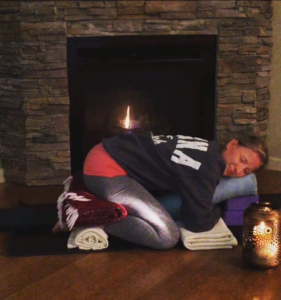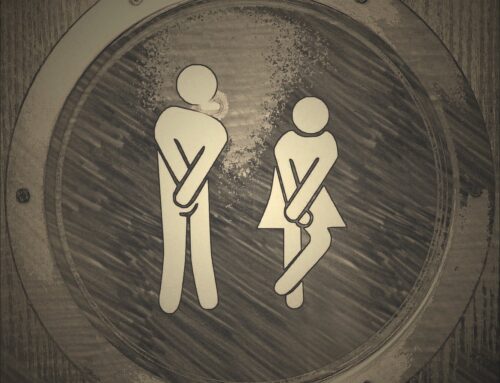
Image credit: Krzysztof Niewolny via Unsplash
Cultivating awareness is one of the first steps to changing pain. Breath and body awareness practices can be effective methods for pain reduction in people suffering from persistent pain.
I offer this pelvic floor awareness meditation practice for people suffering from persistent pelvic pain and have found it to be a valuable and successful technique to help calm the nervous systems, reduce the threat input, and modulate the pain experience which is essential prior to introducing challenging movement practices.
Position:
It is important that the position feels as comfortable, safe, and supportive for the person as possible, without experiencing physical or mental distress. One position that many find helps promote pelvic floor awareness is ‘Supported Child’s Pose’ (on knees, sitting back onto heels, heels and knees apart, hips in abduction and slight external rotation as tolerated) with a bolster or rolled blanket in between the thighs and gently contacting the perineum to provide tactile feedback.

The YouTube video of preparing for this position can be found here
The YouTube video of preparing for this Supported Child’s Pose position can be found here
Allow the weight of the trunk to fully rest onto the bolster or blanket. Adjust the height so it feels as comfortable and fully supportive as possible. Blankets behind the knees or under the ankles may be required for added comfort.
For those unable to get into this position, other options such as supported lying positions in supine, side lying, or prone can also be used. A seated position at the edge of the chair, with legs apart (hips in abduction) and trunk relaxing forward with arms and trunk supported on a table or on a few pillows or bolsters stacked on the lap can also be an option.
The cueing used in the pelvic floor awareness meditation below assumes the ‘Supported Child’s Pose’ position. Remember to give yourself permission to pause and adjust your position at any time during the practice if you need to.
Meditation:
Bring your awareness to the breath without trying to change it. Notice the rhythm (is it fast or slow), the depth (is it shallow or deep), the texture (is it rigid or smooth), and the length of the inhale compared to the length of the exhale.
Notice how the breath moves the body. Upon inhalation, allow the belly to naturally expand outwards as it descends towards the earth; and on exhalation, notice how it returns to its resting position.
Bring your awareness to the pelvic floor. Visualize your pelvic floor and its connections: from the tailbone at the back, expanding to the two sit bones and connecting to the sides of the pelvis and the pubic bone in the front; like the shape of a diamond.
See if you can notice how the pelvic floor moves in synch with your breath rhythm. It’s okay if you can’t feel it right away – you can even just imagine that you are allowing the pelvic floor to naturally descend, expand, and widen upon inhalation; and then visualize the pelvic floor recoiling passively as it ascends or draws up and in upon exhalation.
Allow a natural rhythm and movement to emerge. Descending on inhalation; ascending on exhalation.
Do not force or ‘push’ the pelvic floor down on inhalation, it will do this on its own, as you allow.
Perhaps you feel the subtle rhythmical movement from the feedback of the bolster or blanket against the perineum.
Inhale: visualize the pelvic floor descending, expanding, and ‘receiving’ the pelvic organs.
Exhale: visualize the pelvic floor returning back up and in (to its resting dome-shaped position).
Inhale: allow the pelvic floor to release, expand, and widen. If it feels safe, see if you can let go what isn’t serving you right now. Notice if you are holding tension, guarding, or holding back, anywhere.
Exhale: do nothing. Observe any thoughts, judgements, or stories that may arise. If you get caught up in the story, notice the elaboration, and compassionately bring yourself back to the present task of noticing the breath rhythm.
Inhale: Feel the belly and pelvic floor expand as you visualize both the pelvic and respiratory diaphragms descending.
Exhale: Visualize both the diaphragms ascending, in synch, returning back up into their dome-shaped positions.
See if you can try to allow this natural rhythm of the pelvic diaphragmatic breath to emerge.
Notice any tension developing in the body. Explore what it means for you to create space, trust, allow and let go.
Explore how it feels to introduce an intention that you can silently repeat to yourself, along with the rhythm of the pelvic diaphragmatic breath cycle:
Inhale, silently repeat: “I am safe”
Exhale, silently repeat: “It’s okay to let go”
Inhale: “I am safe”
Exhale: “It’s okay to let go”
Continue repeating this intention silently, with the breath cycle for about 1-3 minutes.
If thoughts, emotions, physical sensations or elaborative stories distract you; that is okay. Acknowledge them, maybe even thank them for appearing, and bring your awareness back to the presence of the intention and the pelvic diaphragmatic breath rhythm. The moment you realize you have been distracted, is the moment that provides you with the golden opportunity to practice compassion towards yourself and discipline to re-focus your attention to present moment awareness. That is part of this meditation practice.
**For the audio recording of this meditation click here. For a video demonstration of this meditation and other yoga techniques used to enhance awareness, excursion, engagement and relaxation of the pelvic floor, please see
“Creating Pelvic Floor Health with PhysioYoga” downloadable videos created by Shelly:
https://vimeo.com/ondemand/pelvicfloorhealth
**This article, video and video links are not meant to diagnose, treat, or act as medical advice. Please consult your health care provider for clearance and guidance before following or participating in these activities.**




